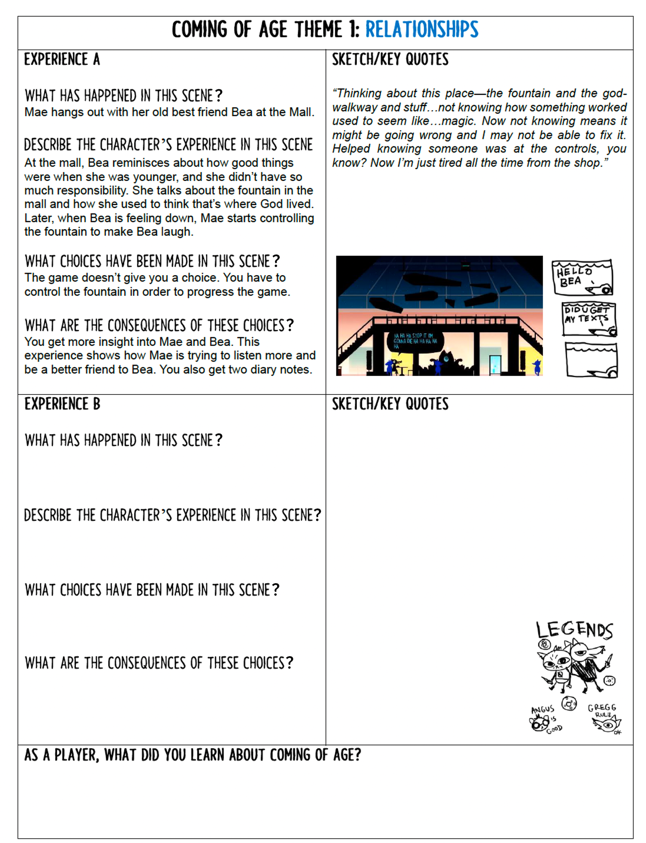
by Stephen Henriques
Cranbrook’s English Department recently partnered with University of Sydney Associate Professor Jen Scott Curwood, to explore whether using specific video games could enhance a student’s comprehension and engagement with narrative conventions.
Cranbrook School’s vision is to encourage and support all students so they can fulfill their potential inside and outside the classroom. The English Department is committed to innovative English pedagogy, looking for ways to make topics fun and engaging. We hope this counters student apathy, increases their interest, and enables them to communicate learning experiences with others.
In Term 4, 2023, we selected a popular video game called Night in the Woods, and asked students to play the game, while taking note of different aspects of narrative storytelling and how each element related to the ‘Coming of Age’ theme. In the past, students have investigated this theme by looking at the texts, Who do You Think You Are with Adam Goodes and Whale Rider.
The ‘Coming of Age’ theme is part of the curriculum for English Literature, and explores individualism and identity, looking at literature versus reality when addressing what it is like to grow up. In this study, we looked at three different Coming of Age themes, relationships, wellbeing, and societal issues.
Night in the Woods was created by the Hobart-based game development company Secret Lab. As part of our work with the University of Sydney, co-founder Dr Jon Manning visited Cranbrook to talk to the Year 7 students about his experiences earning a PhD in human-computer interaction, becoming a game developer, and being an entrepreneur. The boys were eager to hear about his experiences, and their active engagement was evident through their rapt attention and thought-provoking questions.
The selection of the game in this study was important. Often when people think of video games, they think of first-person shooter games like Call of Duty and others. In contrast, Night in the Woods is an adventure game where the key actions for the main character, a university drop-out called Mae who returns to her hometown, are centred around whether she should explore, converse, or see and touch. The decisions the student makes affects the outcome of the story.
When playing Night in the Woods, students examined how the game developers used game techniques and narrative techniques, looking at world building, characterisation, setting, plot, sounds, symbolism and metaphor, dialogue, colour, consequences of choices and other narrative conventions. Each student kept a journal, writing observations and responding to points of stimulus in the booklet. Within the game, the protagonist Mae keeps a journal as well, and sketches from Mae’s journal were included to show students how to represent their work in words and other multimodal forms.

To end the research project, we asked our students to be pioneers and to help us assess whether this unit should be part of the curriculum. The majority of Year 7 students thought that narrative-driven games are an engaging, thought-provoking multimodal genre for inclusion in formal school contexts. Some students, even avid gamers, thought that games were better suited for leisure though. For a Year 7 student, the opportunity to provide valuable feedback is incredible, as it places value on their perspective and their voice; placing the student in charge of the curriculum and to observe how to make learning more engaging.
Parents of the students involved were also wholly supportive. It was initially a concern of some that we would be adding to their student’s screentime by playing this game. However, I firmly believe that screen time only becomes an issue when the time on screens isn’t being used effectively. It is important that time spent on screens is constructive, has a purpose and isn’t a mindless time sponge. The interactions with the Night in the Woods had purpose and meaning, and I found students were highly engaged in exploring the ‘Coming of Age’ theme as we were using a media most students were familiar with, to engage with English in a progressive and modern setting.
To end the project, we invited some teachers to act as a judge on a panel in a Shark Tank style format. The final presentations were exemplary across the board. The students’ passion and hard work were clear for all to see, and their perspectives were conveyed with insight, enthusiasm, and expertise.
The new 2024 English curriculum includes digital texts for the first time, and to help us be prepared for this change, we thought the research partnership with the University of Sydney came at the right time. The University partnership offered hands-on professional development to the English faculty to advance our knowledge of digital texts like videogames. It was also a fantastic opportunity for us to engage with researchers to explore how we can approach a more sustained look into narratives in a modern setting. This plays to the fact there are ongoing conversations around how we can engage young people with wide reading and how we can foster that growth and love of literature and reading, so that kids can delve into a game and observe the elements of narrative and world building that are important.
Engaging with digital texts like Night in the Woods within the school context encourages young adults to be more critical media consumers whilst also deepening their understanding of traditional narrative conventions. The partnership with the University of Sydney also allowed the Year 7 students to gain insight into the game development industry and how they can leverage their interests in programming, design, and entrepreneurship into viable careers.
Stephen Henriques is Head of English at Cranbrook, an Anglican independent day and boarding school for boys, Pre-school to Year 12.


